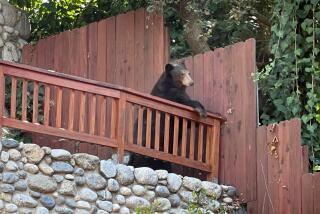Teddy bears’ faces say, ‘Take me home,’ and the society’s members do.
- Share via
Bea Wilson took one of her teddy bears to an ice cream parlor and sat him down opposite her. “I ordered, and waited for the waiter to react, but he didn’t,” recalled the teddy bear fancier, who says 100 or so bears are overflowing her Lomita home.
Dianne Milam, who says she must have 300 bears by now, rides around with two of them in the back seat of her car, and “they wear seat belts.”
Kathy Moss has scores of them in her Gardena home on sofas and chairs, and one is even enthroned on a portable child’s potty.
Teddy bears, which have long had homes in the hearts of millions of children who have cuddled them at night, have taken up residence on the sofas, chairs and shelves of folks old enough to have children or grandchildren.
Said Wilson: “You can confide in them, and they won’t tell your secrets. They don’t eat crackers in bed, and they don’t tell you anything you don’t want to hear.”
Wilson and the other women, members of the nonprofit South Bay Teddy Bear Society, will try to show people why teddies are so special at their annual show and sale Saturday at the Torrance Holiday Inn. Proceeds will buy bears for children in the pediatric cardiac surgery program at Memorial Hospital of Long Beach.
Collectors of teddy bears--both hobbyists and people who make bears to sell--will display everything from bear furniture to bear clothing. Some of the items will be for exhibit only, and hundreds of handmade bears will sell for prices that start at $15. The show will feature tips on making your own bear, a raffle with bear prizes and a bear costume contest with a country-Western theme.
Though some teddies are only a few inches tall, they have turned into a giant hobby, according to society members, who say bears are among the top 10 of American collectibles and have spawned bear shops, books and magazines.
There can be money in teddies--some turn-of-the-century old-timers are worth thousands of dollars. But these women say most collectors are simply smitten by the soft, cuddly creatures, whether the bears sport granny glasses, wear a red, white and blue clown outfit, or, like the Chippendale’s bear, little at all.
“All of their faces say, ‘Take me home,’ ” said Wilson.
And, society members say, there’s a reason why the term “care bear” has become so popular.
“You go into any hospital, and you see lots of bears--flowers, candy and bears,” said Kathy Sandusky, a collector and maker of teddy bears who also works at a hospital. “They’re a comforting kind of thing.”
One reason the Teddy Bear Society was organized six years ago was to provide bears for abused and ill children as well as to senior citizens. “A bear is a security blanket for children in a traumatic situation,” Moss said. “They’re soft, lovable and squeezable.”
She learned about the therapeutic power of bears on a rainy day in 1985. “I was down and depressed,” she recalled. “I saw a teddy bear and I purchased it.” Then, in a remarkable coincidence, she passed a Holiday Inn on her way home, where the Teddy Bear Society’s show was in progress. “I went in, and a whole new world opened up,” Moss said with a smile.
According to society members, teddy bears came along at the turn of the century, both in the United States and in Germany. President Theodore (Teddy) Roosevelt lent his name to them in 1902, when he refused to shoot a bear cub that someone had herded in his direction during a hunting party. Cartoonists soon began showing him holding a toy bear, which forever became known as the “teddy bear.”
At their monthly meetings, the 25 bear society members listen to bear talks--topics include how to photograph them--and have workshops on bear-making. There is a bear fashion show at every meeting, and at one gathering a bear wedding was staged, complete with gowned bride and attendants.
Of course, there will be a Halloween party next month, with everyone, especially the bears, in costume.
More to Read
Sign up for Essential California
The most important California stories and recommendations in your inbox every morning.
You may occasionally receive promotional content from the Los Angeles Times.













